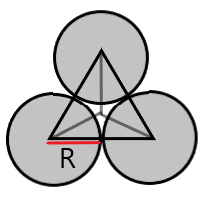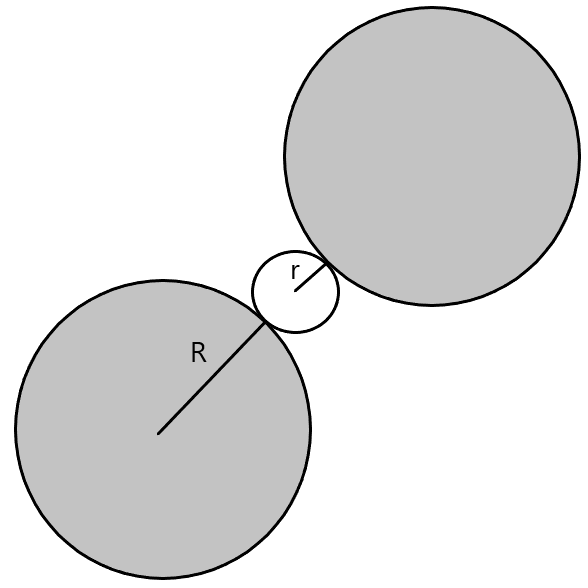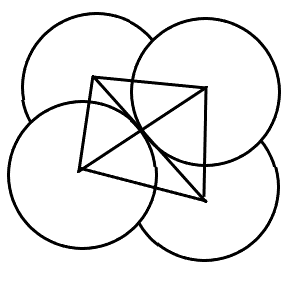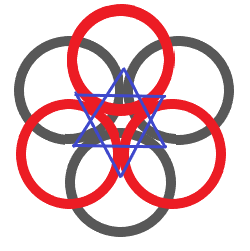
Answer
375.9k+ views
Hint: To determine which void is the largest, we first need to know what are voids. In a solid-state, most have a crystalline structure whose constituents particles form closed packed structures. The vacant spaces and the gaps between these constituent particles are known as voids.
Complete answer:
Solids usually form a closely packed pattern in three ways.
1. 1-dimensional close packing
2. 2-dimensional close packing - In this, atoms can be arranged either in hexagonal close packing or in square close packing.
3. 3-dimensional close packing - In this, atoms can be arranged either in a cubic close-packed structure (CCP) or a hexagonal close-packed structure (HCP)
The orientation of the spheres of the constituent particles determines the name of a void.
The coordination number of a void of 1 unit of a crystal lattice can be defined as the number of particles that are in contact and form the void in a crystalline solid.
In a crystal lattice, the radius of the sphere is denoted by R whereas the maximum radius of the sphere which can be placed inside the void of that crystal lattice is given by r.
Now, let us understand the voids given in the question.
(A) Triangular Void- These voids are formed when spheres are arranged in 2D hexagonal close packing.

Coordination number = 3
r = 0.155R
(B) Cubic Void - These voids aren't usually formed in a closed packed structure but instead are formed when spheres are arranged in a 3D way on all the corners of a cube.

Coordination number = 8
r = 0.732R
(C) Tetrahedral voids- These voids are formed when spheres are arranged in a 3D way such that a sphere is placed on the void of a layer of spheres.

Coordination number = 4
r = 0.225R
(D) Octahedral voids - These voids are formed when spheres are arranged in a 3D way such that the voids of layers of spheres are placed one above.

Coordination number = 6
r = 0.414R
Since the radius of the cubic void is the largest hence option (B) cubic voids are the largest voids.
Note:
It should be noted that relative sizes of anions and cations can be used to determine the size of the ionic solids when the following conditions are met.
- The hard-sphere of anions and cations are in contact.
- Anions will not be in contact with each other but will be close enough.
- As many anions as possible should surround the cations.
Complete answer:
Solids usually form a closely packed pattern in three ways.
1. 1-dimensional close packing
2. 2-dimensional close packing - In this, atoms can be arranged either in hexagonal close packing or in square close packing.
3. 3-dimensional close packing - In this, atoms can be arranged either in a cubic close-packed structure (CCP) or a hexagonal close-packed structure (HCP)
The orientation of the spheres of the constituent particles determines the name of a void.
The coordination number of a void of 1 unit of a crystal lattice can be defined as the number of particles that are in contact and form the void in a crystalline solid.
In a crystal lattice, the radius of the sphere is denoted by R whereas the maximum radius of the sphere which can be placed inside the void of that crystal lattice is given by r.
Now, let us understand the voids given in the question.
(A) Triangular Void- These voids are formed when spheres are arranged in 2D hexagonal close packing.

Coordination number = 3
r = 0.155R
(B) Cubic Void - These voids aren't usually formed in a closed packed structure but instead are formed when spheres are arranged in a 3D way on all the corners of a cube.

Coordination number = 8
r = 0.732R
(C) Tetrahedral voids- These voids are formed when spheres are arranged in a 3D way such that a sphere is placed on the void of a layer of spheres.

Coordination number = 4
r = 0.225R
(D) Octahedral voids - These voids are formed when spheres are arranged in a 3D way such that the voids of layers of spheres are placed one above.

Coordination number = 6
r = 0.414R
Since the radius of the cubic void is the largest hence option (B) cubic voids are the largest voids.
Note:
It should be noted that relative sizes of anions and cations can be used to determine the size of the ionic solids when the following conditions are met.
- The hard-sphere of anions and cations are in contact.
- Anions will not be in contact with each other but will be close enough.
- As many anions as possible should surround the cations.
Recently Updated Pages
How many sigma and pi bonds are present in HCequiv class 11 chemistry CBSE

Mark and label the given geoinformation on the outline class 11 social science CBSE

When people say No pun intended what does that mea class 8 english CBSE

Name the states which share their boundary with Indias class 9 social science CBSE

Give an account of the Northern Plains of India class 9 social science CBSE

Change the following sentences into negative and interrogative class 10 english CBSE

Trending doubts
Fill the blanks with the suitable prepositions 1 The class 9 english CBSE

Which are the Top 10 Largest Countries of the World?

Give 10 examples for herbs , shrubs , climbers , creepers

Difference Between Plant Cell and Animal Cell

Difference between Prokaryotic cell and Eukaryotic class 11 biology CBSE

The Equation xxx + 2 is Satisfied when x is Equal to Class 10 Maths

Change the following sentences into negative and interrogative class 10 english CBSE

How do you graph the function fx 4x class 9 maths CBSE

Write a letter to the principal requesting him to grant class 10 english CBSE



